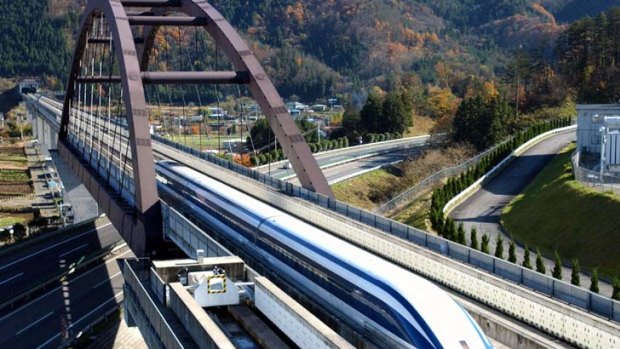By Mark Russell

Lagging transport... Australia is the only continent in the world without a high-speed train. Above, a magnetically levitated train in Japan.Credit: AP
AUSTRALIA is lagging behind much of the rest of the world as more countries turn to high-speed trains to meet their future long-distance transport needs, according to the Australasian Railway Association.
"Australia is the only continent apart from Antarctica that doesn't have a high-speed rail network," its chief executive, Brian Nye, said. "The time has come."
Mr Nye pointed to a recent report from the Worldwatch Institute in Washington which found that by 2015 high-speed trains would be operating in 24 countries, compared with 14 today, as evidence Australia was behind the times.
The number of high-speed trains increased from 1737 worldwide in January 2008 to 2517 in January last year. The global fleet is expected to total more than 3700 by 2015.
The rising demand for high-speed trains, Worldwatch says, is due not only to speed but to their reliability and the diminishing appeal of air travel because of airport security checks.
Mr Nye said it would take eight to 10 years to build a high-speed rail network from Melbourne to Sydney alone at a cost of about $35 billion, but there was no doubt it would pay for itself in the long term.
An Access Economics report for the association, which represents the rail industry in Australia and New Zealand, also found a high-speed network would cut emissions, as one passenger train could take 525 cars off the road.
High-speed rail has been under consideration in Australia since the early 1980s, although no proposal has been regarded as financially viable - mainly because of high construction costs and relatively low population densities.
The issue was back in the spotlight last August when the federal government released a 300-page study on the feasibility of high-speed rail on the east coast.
The $20 million study found passengers could travel from Melbourne to Sydney for $99 in three hours if a 1600-kilometre, high-speed network linking Brisbane, Newcastle, Sydney, Canberra and Melbourne were built at a cost of between $61 billion and $108 billion.
But the government has baulked at the estimated cost of the project and commissioned a second, deeper study, expected to be finished by November.
Sign up for the Traveller Deals newsletter
Get exclusive travel deals delivered straight to your inbox. Sign up now.